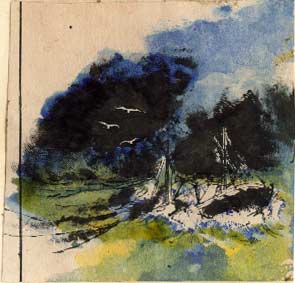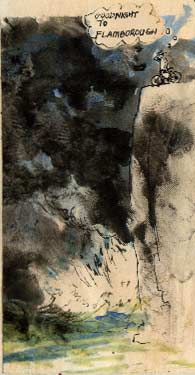At
the Grave of William Baines
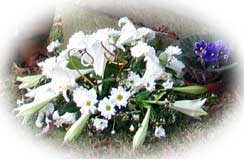 Although
it’s exactly 85 years since
William died of tuberculosis, aged only 23, today felt like a celebration.
The floral tribute
was
arranged
by Joan
Fawcett of the Civic Society; she went for the natural look,
to reflect William’s love of nature which is so evident in his
music, to which she added a large treble clef fashioned from
metallic tubing. Although
it’s exactly 85 years since
William died of tuberculosis, aged only 23, today felt like a celebration.
The floral tribute
was
arranged
by Joan
Fawcett of the Civic Society; she went for the natural look,
to reflect William’s love of nature which is so evident in his
music, to which she added a large treble clef fashioned from
metallic tubing.
Robin Walker, who also added a small floral tribute,
is the composer At the Grave of William Baines,
first performed in Manchester in January
2000.
Student Project
In 1972, the 50th anniversary of William's death, I did some research,
talking to his surviving friends and relatives as my final project at
Leeds College
of Art. This resulted in a leaflet (still available from me!), two concerts
and an ambitious exhibition for the Harrogate Festival which
included a slide
show set to some of his music and reconstructed rooms representing the
phases of William’s life.
Going through my Baines files to find material for this afternoon’s
walk, I came across these pen and ink drawings (below) from
an early rough for the leaflet. They’re my interpretations of his
composition for piano, Paradise Gardens, inspired by the view
from the walls of York on a summer evening, Goodnight to Flamboro’,
in which you can hear the rhythm of the waves, and The Lone Wreck.
I was more adventurous with my colour in those days. Perhaps Baines was
a good influence on my imagination.
I also see a strong influence from Victor
Ambrus, you can see I've tried to go for his wiry line, tumbling
compositions and lively use of thumb-prints. |
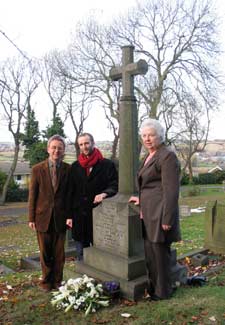
Robin Walker, composer; Robin Lawrence, Friends of Horbury Library
& Joan Fawcett, Horbury Civic Society at the grave this afternoon.
|
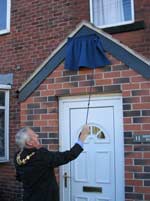
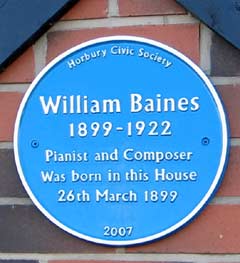 AT
12.45 p.m. today, the Mayor of Wakefield unveiled a plaque at the birthplace
of composer William Baines (1899–1922) at
11 Shepstye Road, Horbury. The Civic Society, with the enthusiastic
support of the Friends
of Horbury Library, hope this will be
the first of several plaques they have planned for the town.
AT
12.45 p.m. today, the Mayor of Wakefield unveiled a plaque at the birthplace
of composer William Baines (1899–1922) at
11 Shepstye Road, Horbury. The Civic Society, with the enthusiastic
support of the Friends
of Horbury Library, hope this will be
the first of several plaques they have planned for the town.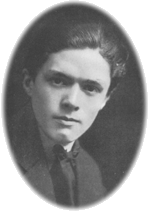 After
a buffet lunch at the library, I led a group of 30 people on a walk around
the Bainesian
corners of Horbury;
After
a buffet lunch at the library, I led a group of 30 people on a walk around
the Bainesian
corners of Horbury; Although
it’s exactly 85 years since
William died of tuberculosis, aged only 23, today felt like a celebration.
The floral tribute
was
arranged
by Joan
Fawcett of the Civic Society; she went for the natural look,
to reflect William’s love of nature which is so evident in his
music, to which she added a large treble clef fashioned from
metallic tubing.
Although
it’s exactly 85 years since
William died of tuberculosis, aged only 23, today felt like a celebration.
The floral tribute
was
arranged
by Joan
Fawcett of the Civic Society; she went for the natural look,
to reflect William’s love of nature which is so evident in his
music, to which she added a large treble clef fashioned from
metallic tubing.

